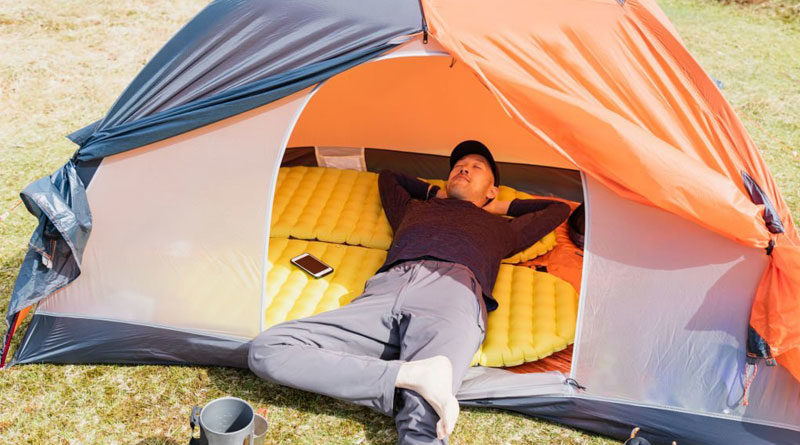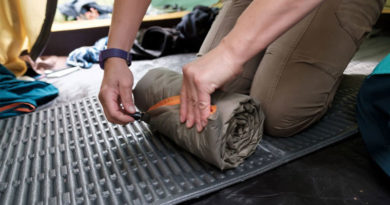Foam vs. Air Sleeping Pad: Which is Better?
Many people use sleeping pads for camping because they provide cushioning from the hard ground and also insulation to keep you warm. The most common types of sleeping pads are air pads and foam pads. If you want a sleeping pad you might be stuck between foam and an inflatable pad, keep reading because this guide is for you.
Both types of sleeping pads have their ups and downs and the one you want depends on your intended use. Air pads are more comfortable but expensive while foam pads are cheap and more durable. Let’s dive into the details of the pros and cons of both types of sleeping pads.
What is a Closed-Cell Foam Sleeping Pad?
Closed-cell foam sleeping pads (CFF), as per the name, are pads made of closed-cell foam. Closed-cell foam is a dense foam made of tiny closed pockets or cells full of air. These air-cells trap body heat to provide insulation.
Pros
- The most significant benefit of using a CFF pad is that you never have to worry about punctures. You won’t have to carefully search the site for sharp thorns or rocks that can puncture your sleeping pad. You won’t have to deal with patch kits and a CFF pad allows you to sleep directly on the ground. Foam pads allow you to have more campsite options allowing you to camp in rugged environments.
- CFF pads are cheap. You can buy a CFF pad for somewhere around $20. If you find one on sale, you get them for even less. Even the high-end foam pads cost less than their cheapest counterparts because the manufacturing process of foam pads is simpler than that of air pads.
- Foam pads take far less time to set up. You just unstrap or take it out of your backpack and simply unroll it on the ground. That’s it! You don’t need time to inflate it. If you are too tired and too sleepy after a demanding hike, you would be thankful you don’t have to deal with an air pad.
- Foam pads are very reliable. Even if they are damaged, they can still be used. That means you won’t ever discover that your foam pad is useless because of damage after reaching the campsite. Foam pads just don’t fail suddenly. They are also more durable than air pads because they are not susceptible to punctures. Foam pads can last for decades with proper care. They can even last long after a lot of abuse.
- Reliability and durability make foam pads more versatile which is another strong point of foam pads over air pads. You can use foam pads are padding for other stuff and even floor mats.
- Being durable, they can also be attached to the outside of the backpack without the worry of damage. That means you also get more space inside your backpack.
- Foam pads don’t create any noise like air pads. This is a good point, especially for those who move around a lot during sleep.
- Foam pads provide consistent insulation no matter the weather conditions. You also don’t have to face deflation problems with foam pads as the weather fluctuates.
Cons
- The major downside of foam pads is that they are uncomfortable because they are thin and stiff. They don’t offer as much cushioning and support as air pads and you can’t adjust the firmness as well. For side sleepers and people with back pain, foam pads may not be of use at all because they provide very little cushioning.
- Foam pads weigh a little more and being heavy is another significant downside. The difference is not HUGE, but it still makes a difference. An average foam pad weighs somewhere around 14 ounces. An average air pad weighs somewhere around 12 ounces.
- Foam sleeping pads aren’t as warm as air pads. Foam pads have a lower R-value, that is, it has a range of 0.5 to 2. Their thin structure and lightweight design don’t allow many insulation options added to them. To use a foam sleeping pad in cold weather, you would have to stack two foam pads together or use an additional air pad.
- You can deflate air pads to make them smaller. Foam pads can’t be deflated and so they have bulk to them and take up a lot of space. Most of them can be rolled or folded like an accordion which does make them compact, but still not as compact as air pads.
Therm-a-Rest Z Lite SOL
Weight: 14 ounces
R-value: 2
Dimensions: 72 x 20 inches
Thickness: 0.75 inches
The Z Lite is a good CFF pad because it is lightweight and extremely versatile. You don’t have to worry about punctures or a sudden functional failure like with an air pad. It works even when it gets ripped by sticks and stones. The pad is made of one-ounce segments that make the pad extremely versatile to use. The segments also have metal layering on one side for effective heat reflection. During cold nights, you can have the metal layering towards your back for better heat retention. The Z Lite has an R-value of 2.
The whole pad can be used as a back panel structure in frameless ultralight backpacks. The segments of the pad can also be used as splints for first aid applications. All you need is the right amount of tape and knowledge of what you are doing. The segments are easy to cut and separate.
However, the thickness of the pad is less than 1 inch, ¾ to be precise. It doesn’t provide enough cushioning from the floor but it is still better than nothing. The pad weighs just 14 ounces and the accordion-like folding makes it pack small even though it is still bulky. It is ideal to keep as a secondary pad. Also, if you are looking for comfort, then the Z Lite isn’t for you. It is mentioned above that the major con of foam pads is lack of comfort.
What I like: Cheap, extremely versatile, and lightweight
What I don’t: Uncomfortable
See the Therm-a-Rest Z Lite SOL
What is an Inflatable Sleeping Pad?
Air pads, as the name implies, are inflatable pads that can be filled with air. They have plastic shells and feel like an enlarged balloon.
Pros
- The major advantage of air pads over foam pads is the comfort. They are soft and they also allow you to adjust the firmness of the pad to suit your comfort. This adjustment is very helpful for side sleepers and for people with back pain.
- They also weigh less than foam pads. On average, an air pad weighs 2 – 4 ounces less than a comparable foam pad. The lightweight of air pads makes them ideal for ultralight backpackers.
- Since you can deflate air pads, they are not bulky as foam pads are. Most air pads pack down to as little as one liter of a water bottle. Air pads take up less space in your backpack.
- Because inflatable sleeping pads are thicker, they use certain reflective surfaces and warm materials for insulation. That is why air pads are warmer and have a higher R-value.
Cons
- The major disadvantage of having air pads is that they are susceptible to punctures. You would have to clear your campsite of sharp objects or choose a better campsite altogether. They do come with patch kits but that is added item to carry. Low durability also means that they are not versatile at all.
- Air pads are expensive they cost somewhere around $50. Premium ultralight air pads can cost around $200. Remember, a premium foam pad costs around $50 which is equal to an entry-level air pad.
- Being inflatable, of course, air pads take up a lot of time and effort to set up and pack. This is tedious work if you are thru-hiking or if you intend to camp for a few nights.
- The moisture from your breath can accumulate moisture inside the bag which can cause mold or bacteria growth, another thing to deal with. You can use an air pump which not only avoids moisture buildup inside but also makes the procedure easier. Then again, it is another item to carry.
- Air pads are not as long-lasting as foam pads. Their seams tend to rupture at which point you would have to get a new pad. A premium pad lasts only about 5 seasons.
- They feel like deflating with temperature fluctuation which also affects their warmth.
- These pads tend to be noisy like a balloon. This can be annoying if you move a lot while sleeping or if you are a light sleeper.
Therm-a-Rest NoeAir Xtherm
Weight: 15 oz. (~19 oz. with pump)
R-value: 7.2
Dimensions: 72 x 20 inches
Thickness: 2.5 inches
Therm-a-Rest NeoAir Xtherm is an excellent 4-season option because it has the best weight-to-warmth ratio. Therm-a-Rest updated the NeoAir Xtherm in 2020 with a better valve system and better fabric. This pad is one of the warmest sleeping pads you can find with an R-value of 7.2. The Thermacapture technology of the Xtherm uses reflective metal surfaces to effectively reflect body heat. Yet, the Xtherm can pack extremely tight along with its air pump in the generously-spaced stuff sack that comes with it.
The valve system was updated in 2020 and now features Winglock technology comprising of satisfying-to-turn wings. The valve design isn’t a copy-paste of the designs employed by other brands. The wings flip the main valve between inflate and deflate mode. In inflate mode, the valve locks the air in. The newly included pump sack locks effortlessly to the valve unlike the previous one. The pad with the included air pump weighs almost 19 ounces which is extremely lightweight for the warmth it provides. Although comfortable, the fabric of the pad makes a crinkly sound that can be a problem for light sleepers. It does require some getting used to. The 30D fabric may cause some durability issues but we haven’t had any problems so far.
What I like: Great weight-to-warmth ratio, the updated valve system is great, packs extremely tight
What I don’t: Expensive, makes noise
See the Therm-a-Rest NoeAir Xtherm
Comparison Table
| FEATURE | FOAM PAD | AIR PAD |
|---|---|---|
| Weight | A little heavy | Very lightweight |
| Comfort | Average comfort | Good comfort but noisy |
| Versatility | Versatile, can be used for sitting at the campsite | Less versatile |
| Ease of Carrying | A little difficult due to the large pack size but can be attached to the outside of a backpack. | Easy to carry due to its small pack size. |
| Warmth | Below average warmth | Excellent warmth |
| Puncture Protection | Doesn’t get punctures | Prone to punctures |
| Ease of use | Very easy to use | Requires some efforts to inflate |
| Setup Time | Little to no setup time | Requires some time |
| Reliability | Extremely reliable, can be used even gets damage | Not very reliable |
| Durability | Durable | Less durable |
Which one is right for you?
The function of sleeping pads is to provide insulation to your sleeping bag so that heat from your body doesn’t escape into the ground below. Both air and foam pads perform this function but which one you want depends on a few factors.
You should get a foam pad if you want a more durable and reliable option in summer or mild weather. If you are going camping in rocky areas where you are less likely to find plain camping ground, then a foam pad can help you get through. A foam pad is also a good option if you are not willing to put in the effort to set up your sleeping pad.
If you are camping in cold weather and you want utmost comfort then you should get air pads. But this comfort comes at a price. You would have to keep in mind the extra bucks that an air pad will cost you. You would also have to put in the time and effort to set up an air pad. Air pads are more suitable for campsites where there is more plain land with fewer sharp objects.
A Hybrid System
Many backpackers combine inflatable and foam pads to get the best of both worlds. They do have to carry extra weight but in the end, it’s worth it. An inflatable pad can simply be placed over a foam pad to create an even more comfortable sleeping area. The foam protects the air pad from sharp objects like rocks and twigs that can puncture the pad. That way you can use an air pad even in difficult places. The addition of insulation also keeps you warmer.
The other way around carrying two sleeping pads is to get a self-inflating sleeping pad. Self-inflating sleeping pads also combine the best of both worlds but they are also the heaviest type of sleeping pads.






